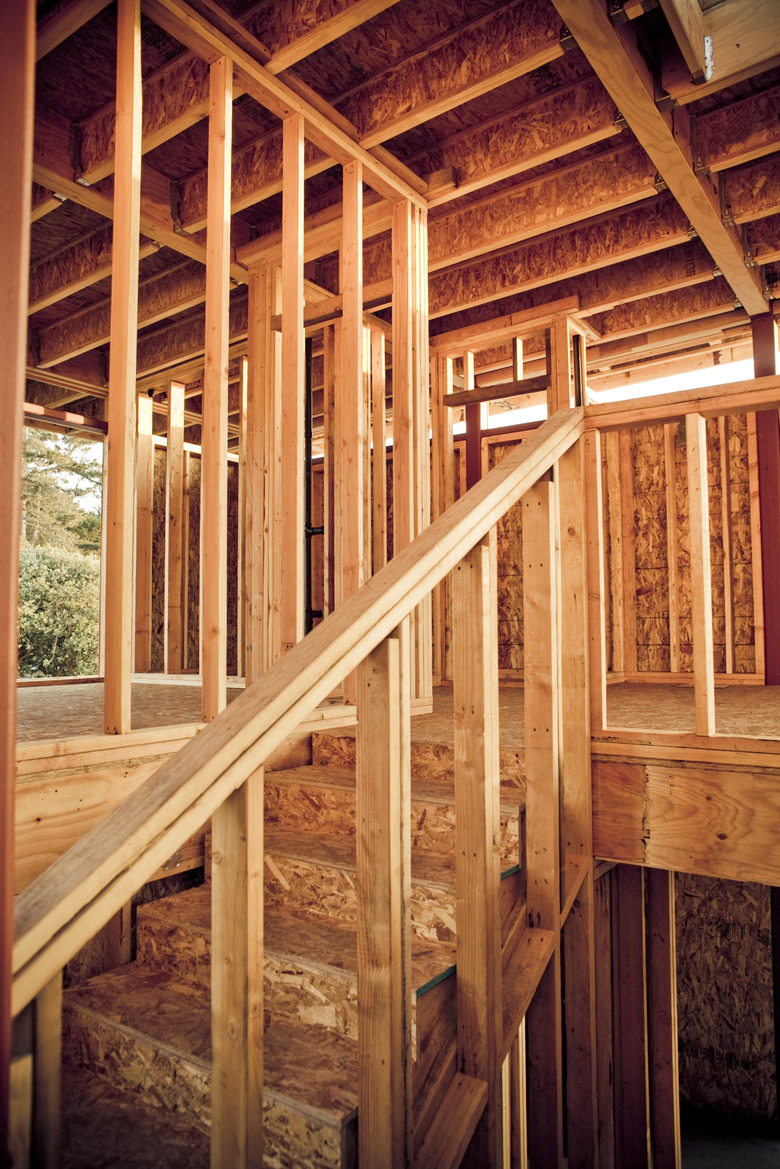How To Build A Narrow Wall
Things Needed
-
Chalk line
-
Laser level
-
Pencil
-
2-by-2 Lumber
-
2-by-4 Wall studs
-
Circular saw
-
Framing nailer
A typical residential wall consists of a floor plate, two ceiling plates, wall studs and 1/2-inch drywall to form a wall that's 4 1/2 inches thick. A narrow wall is 2 to 2 1/2 inches thick, but it is not suitable as a load-bearing wall and local building codes might not allow it between bedrooms. Narrow walls are sometimes found in master suites, separating bath and closet areas within a larger master bedroom. They are also used in open kitchens to conceal the sides of a refrigerator. Except for the smaller width, they look like standard walls.
Step 1
Determine the location of the wall, and snap a chalk line on the subfloor and the ceiling joists to represent the wall. The chalk lines must be plumb with respect to each other, and the simplest way to accomplish this is by snapping the chalk line on the subfloor, and then setting a laser level on the chalk line and aiming the laser beam vertically on the ceiling joists and marking the spot.
Step 2
Cut two, 2-by-2 boards to the length of the wall and lay them side by side. These are the floor ceiling plates. A 2-by-2 board is only 1 1/2 inches wide. When you use 2-by-4 wall studs, which are 1 1/2 inches thick, and turn them sideways, the studs will fit flush with the edges of the floor and ceiling plates. Use wall studs that coincide with the height of the other walls. Buy 8-foot studs for 8-foot walls or 9-foot studs for 9-foot walls. These studs are not 8-feet or 9-feet long, but when added to the thickness of the floor and ceiling plates, they will provide a wall of the desired height.
Step 3
Make pencil marks across both the floor plate and ceiling plate boards at the same time to indicate the location of the wall studs, which should be on 16-inch centers. This means that the center of each stud should be exactly 16 inches from the center of the next stud.
Step 4
Spread the boards apart on the subfloor and lay the wall studs between them. In a standard wall, the studs fit perpendicular to the direction of the plates to give the wall strength. In a narrow wall, they will sit flat between the top and bottom plates.
Step 5
Attach the top and bottom plates to the studs by inserting two evenly spaced 16d nails from the outside of each plate into the ends of the studs. Use a framing nailer to insert the nails.
Step 6
Stand the wall frame up, and align it with the chalk lines on the subfloor and the ceiling joists.
Step 7
Insert one 16d nail through the floor plate into each joist beneath the subfloor. Attach the top plate to the ceiling joists in the same manner. You can now add drywall or paneling.
Tip
Narrow walls do not contain plumbing or ductwork. If permitted by local code, you may install low-profile electrical switches and outlets. The general rule when running wires in narrow walls is to bring the wire in through the floor or ceiling plate and connect it to the outlet in the same stud space. The wall is too narrow to run the wires horizontally through the studs.
If the ceiling joists run parallel to the new wall, install 2-by-4 blocking between the joists to provide a structural surface to which you can nail the top wall plate. Since it's a lightweight, non-load-bearing wall, if it runs parallel to the floor joists, you can just attach it to the subfloor.
Warning
Contact your local building authority to determine when and where it's permissible to build a narrow, non-standard wall.
